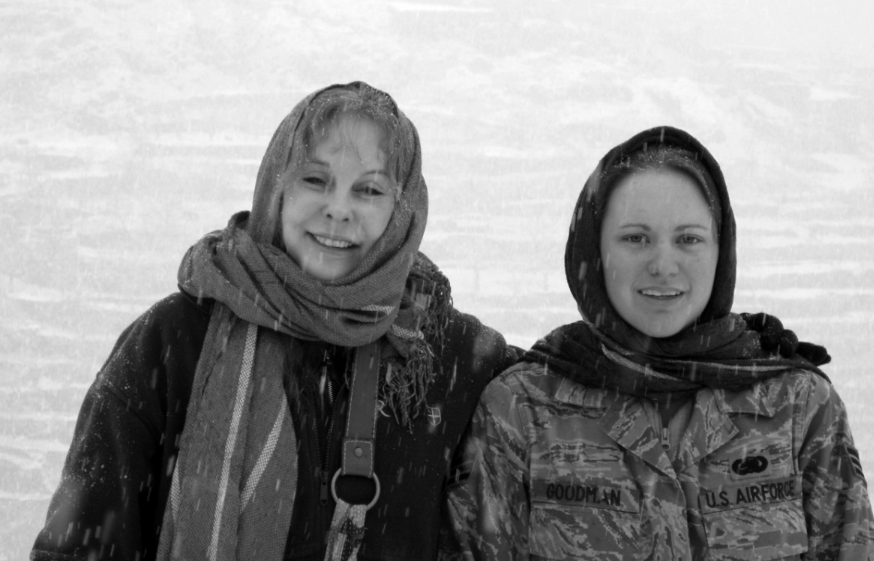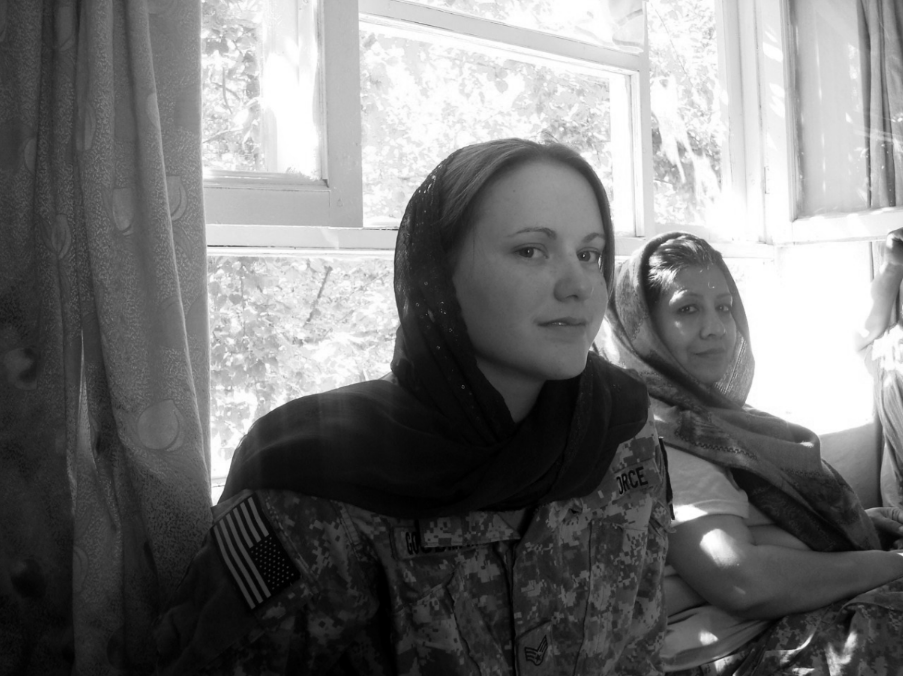Fiction
Thousand Languages
真鍮の反射
Michael McIver真鍮の反射: はじめに
メリッサ・プリチャード (Melissa Pritchard)
2008 年 9 月、アフガニスタンで、PRT(Provincial Reconstruction Team:地方復興 チーム)のメンバーである女性兵士が辺境の地で暮ら しているというネット記事 を読んだ。その人達ははアフガニスタンの村人 たちのために道路 、橋、診療所、学校の建設を支援しているそうだ 。このエッセイは、その経験について書く。人道主義者として平和的に行動する女性兵士に会うという考えに心を奪われてから、米空軍の許可を得て戦争ジャーナリストとして潜入するまで、数カ月に及ぶ集中的な努力を重ねた。 2009年1月、まずバグラム飛行場で女性戦闘パイロットを取材することになった。 それから、パンジシール州のヒンドゥークシュ山脈のふもとにある小さな前方作戦基地を目指して北上する軍の護送車に乗った。
前方作戦基地(FOB)ライオンで、そこに駐留する5人の女性兵士と一緒に暮らし、彼女たちの学校や診療所への任務に同行し、アフガニスタンの英雄であり、パンジシール州の息子であるアフマド・シャー・マスードの墓を訪れ、彼女たち女性兵士が組織した貧困家庭へ援助物資を届けるのを手伝った。これらのミッションで私のドライバーを務めたのは、21歳のアシュトン・リン・マリー・グッドマン上級空兵、通称 "グッドマン "だった。 当初は、彼女の強そうな話し方、罵り、軍人のプライド(そのすべてが、軍隊文化の中で生き残るために培われた見栄であることを、彼女は後に認めている)に少し圧倒されたが、後に彼女をクリエイティブで、非常に知的で勇気ある若い女性として知るようになった。 アシュトンはオンラインのコースを通じて学士号の勉強をし、獣医師になることを計画していた。世界を旅することに憧れ、写真家や作家も目指していた。しかし彼女が書いた「小話」については極めて謙虚だった。
私は帰国してからもアシュトンと文通を続けた 。アシュトンの書いた文章を送ってくれるように頼んだとき、アシュトンは申し訳なさそうにそして、はずかしそうに、送ってくれた。 彼女の小話を読んで、それがアシュトンの性格を如実に反映していることに驚きはしなかった。優しくて、英雄的で、傲慢で、先見の明があって、とても正直で、面白い。 かつてアルベール・カミュが、哲学者であり社会活動家であった友人シモーヌ・ヴェイユのことをこう評したように、アシュトンには「真実への情熱」があった。
女性問題委員会に配属された後、アシュトンは、毎週開かれるシュラ(会議)で村の女性たちと会い、アフガニスタンの女性や子供たちの権利を訴えることに新しい目的を見出した。
アシュトンは、武器ではなく言葉で戦うことを学び、FOBライオンへの2度目の入軍を頼んだと言った。 パンジシールの人々を愛し、女性たちとの仕事に意義を見出していた。 アシュトンが「パンジシールPRTの女性兵士が医療衛生を改善」という最初の記事を空軍のオンラインの雑誌に掲載したとき、アシュトンはそれを彼女の家族とボーイフレンド、そして私に送ってくれた。
2009年5月26日、22歳の誕生日を数日後に控えたアシュトンは、バグラム飛行場へ向かう指揮官の運転中、即席爆発装置(IED)によって死亡した。
悲しいときの本能の一つは、追悼することであり、尊敬によって亡くなった人を生かしておくことである。 2009年11月、『Collagist』誌は、パンジシール州PRTの5人の女性兵士をを紹介する私の記事を掲載した。2010年5月、『O, The Oprah Winfrey Magazine』誌は、アシュトンについての私の特集記事を掲載した。2010年6月、私はアフガニスタン女性ライティング・プロジェクトと共にアシュトン・グッドマン基金を設立した。アシュトン基金への寄付により、カブールとヘラートに女性のための安全な執筆のための家を2軒建設し、インターネット・アクセス、ノートパソコン、小さな図書館を設置しました。
12月、私は空軍技術研究所で1000人近い空軍将校を前に、アシュトンの人生と、アシュトンが、アフガン女性へ献身したことについて語った。2011年5月、アリゾナ州立大学のクリエイティブ・ライティングの修士課程に在籍する9人が、アフガニスタンの女性作家による詩と散文の大学初の朗読会に参加した。しかし、まだ守られていない自分との約束があった。アシュトンが亡くなる前、私は彼女に助言して、アシュトンの小説を少なくとも一つ出版する手助けをすると誓っていた。ヘイデンズ・フェリー・レビューは、ローラ・アシュワースとケント・コービンという今の編集者(へんしゅうしゃ)のおかげで、その約束を守る機会を与えてくれた。
「真鍮の反射』は、インディアナ州の自宅近くに埋葬された若い兵士の遺品である。獣医、作家、写真家、妻、そして母になる夢を抱いていた若い女性は、勝ち目のない戦争で激しく打ち砕かれた。この短い作品は、アシュトンがイラクで19歳の兵士だったときに書かれたもので、アシュトンの作家としての可能性をほんの少し見せてくれる。この文章を書いたときのアシュトンは、亡くなる数カ月前に大きく変貌した。アシュトンが "武器ではなく言葉の力 "を使って、アシュトンはアフガニスタン女性の権利の代弁者となった。アシュトンは、これらの武器を、診療所や学校、記事といったものだけでなく、強さと優しさ、そして激しい共感の声として、その姿を変えていった 。
作家のメアリー・ゴードンは、著書『ジャンヌ・ダルク』の中で、15世紀のフランスの戦士である聖女をこのように描写している:
『ジャンヌは若い少女のような無頓着さ、自信、降伏の覚悟ができている。人生を愛し、死ぬことをおそれている。この生意気で、純粋で、腹立たしくて、賢明でない少女は、自分よりも大きな大義のために我を忘れた。饒舌でありながら自己矛盾に満ちていた。しかし、死の間際でも彼女は定義されることを拒む 』
純粋で、腹立たしくて、生意気で、自信がある。自分よりも大きな大義に身を委ね、人生を愛し、一人を拒む。
ああ、アシュトン。
真鍮の反射
アシュトン・リン・マリー・グッドマン [ASHTON LYNN MARIE GOODMAN]
2008年1月17日 - 9月
真鍮の雨が降っていた。自動機関銃の真鍮だ。砲塔から降り注ぐ。これはボディーアーマーに当たって無害だった。 殺傷弾はすでに射程にあり、戦車の焼け焦げた砲弾に埋め込まれていた。外は暗 かった。
現職の砲手は砲塔の中で立ち上がり、両手でM249軽機関銃のバットストックを握っていた。彼の顔はサーマルサイトに押しつけられ、ターゲットであるはずの白、緑、黒の斑点を見分けるのに必死だった 。
砲手の足が私の隣で容赦なく動き、彼は最良の姿勢を見つけ、最も正確な弾丸だけを射程に送り込もうとした。この暗い夜、私たちの訓練任務は、教わった規則に従って「敵戦車」と交戦し、撃破することだった。 砲手は、「確認・交戦中」のあとに「敵のタンクは、12時に600mにある」と言った。いつから私たちにとって殺戮や破壊が当たり前になり、それが普通になってしまったのか。この武器を実際の人間に向けて撃つとき、私は何かを感じるはずだったのだろうか? しかし、そんなことを考えている時間はあまりなかった。 「ガンナー、寝転べ!」ハンヴィーの中で士官が叫んだ。 彼は交代するときだと知らせてくれた。誰かが銃を持つ番だった。私の番だ。鎧を着込んでいても、小柄な私は簡単に戦車の砲塔に入ることができた。 前任の砲手はそう簡単にはいかなかった。砲塔に彼を入れるために、車内の体重と体格が大きい他の兵士たちが引っ張られ、格闘したのだ。 彼は私の前の座席に倒れ込み、大きなため息をついた。 これは普通のことだろうか?実際に人を撃つとき、私は何かを感じるのだろうか?
戦車内の新しい場所から周囲を見渡した 。どこもかしこも真っ暗で、夜中にトレーサー弾が飛んできたり、時々、手榴弾の閃光の光だけがある程度だった。「もっと弾薬を!」。声を荒げて叫んだ。殺しの練習をしていた。軍隊生活の初期、様々な射撃場で殺しの練習にとんでもない時間を費やすことに慣れていた。
テストのための武器は何十種類もあった。 この特別な射撃場は、ガンナーがハンヴィーの砲塔に乗り、手にした武器が発射される感覚に慣れる時間を与えるために設計された。
武器を手にしたときの感覚は強烈だ。自由と義務感がある。 ベルト状の弾薬を装填し、給弾トレイを閉じた。バットストックは手袋をはめた手の下で滑らかだった。グリップと手の位置が最適になるよう、銃の周りを触った。
射撃場は驚くほど静かだった。私は銃を引き金にかけ、標的を確認した。遠くに見える戦車を敵だと想像した。敵のことを考えるとき、兵士たちが抱くような怒りを感じたことはなかった。敵に対して本当に何も感じなかった。これは冷淡さの表れなのか、それとも対処法なのか。いずれにせよ、そんなことはどうでもよかった。
幹部はボンネットの上に飛び乗ると、私が正しく装填したことを確認するために武器を点検した。私は引き金に指をかけたまま、魔法の言葉を待った。「敵戦車、400メートル、12時方向。確認。交戦。」引き金を一気に引き戻すと、銃身から弾丸が夜に向かって爆発した。
私が実際に標的に命中したことを示す唯一の指標は、レーンの土手を照らす鮮やかな火花だった。M249SAWでは5発から7発のバーストが標準であり、この数を数えるために私は頭の中で「死ね、くそやろう、死ね、死ね、くそやろう、死ね」と唱えた。
ついに弾薬が尽きた。銃身がかすかにオレンジ色に光り、雨粒が熱い金属に落ちてジュウジュウと音を立てた。幹部は私に銃弾を取り除くよう吠えたが、すでに終わっていた。
私が砲塔を出ると、次の兵士が同じ訓練を繰り返すために上がっていった。私は防弾服のまま、彼が空けた席に座り、戦場の音楽に耳を傾けた。手榴弾の閃光が稲妻のように暗い空を照らした。それは、遠くに放置された戦車のシルエットを確認するのに十分な明るさだった。
雨粒が私の装甲を打ち、金属に当たってカチャカチャと小さな音を立てた。基礎訓練で初めて武器を撃ったときのことを思い出した。私のM16は古くてボロボロだったが、仕事はこなした。最初はライフルの重さと、その武器がほかの人を殺せることを恐れていた。
しかし、武器は道具に過ぎないと理解するまで、そう長くはかからなかった。
武器は言われたことしかしない。
Share This Japanese Translation
Reflejos en Latón
Fabián M Díaz Chacinuna introducción por Melissa Pitchard
En septiembre de 2008, leí un artículo en línea sobre soldados femeninas en Afganistán, miembros de los Equipos de Reconstrucción Provincial, o PRT, que vivían en provincias remotas, ayudando a construir carreteras, puentes, clínicas médicas y escuelas para los aldeanos afganos.
Es una historia en sí misma: cómo pasé de estar cautivada por la idea de conocer a soldados femeninas actuando en una capacidad pacífica como humanitarias, a varios meses de esfuerzo intensivo, obteniendo permiso de la Fuerza Aérea de los Estados Unidos para ser una periodista de guerra incrustada. Pero en enero de 2009, me encontraba primero en la Base Aérea de Bagram, entrevistando a pilotos de combate femeninas, y luego en un convoy militar viajando al norte hacia una pequeña base de operaciones avanzadas en las estribaciones de las montañas del hindú Kusch en la provincia de Panjshir.
En la Base de Operaciones Avanzadas (FOB) Lion, viví con las cinco mujeres militares allí, acompañándolas en misiones a escuelas y clínicas, visitando el santuario de Ahmad Shah Massoud, el héroe de Afganistán y un hijo de la provincia de Panjshir, y ayudando en la entrega de ayuda a familias empobrecidas organizada por estas soldados. Mi conductor en estas misiones era Ashton Lynn Marie Goodman, de veintiún años, o "Goodman", como prefería que la llamaran. Inicialmente intimidada por su lenguaje duro, sus palabrotas y su valentía militar, toda una fachada, como admitió más tarde, cultivado para sobrevivir en una cultura militar, llegué a conocerla como una mujer joven voluble, ingeniosa, altamente inteligente y valiente. A través de cursos en línea, estaba estudiando para obtener su licenciatura y planeaba convertirse en veterinaria. Anhelaba viajar por el mundo y era una aspirante a fotógrafa y escritora, extremadamente modesta acerca de lo que llamaba sus "pequeñas historias".
Cuando regresé a casa, mantuvimos correspondencia. Cuando le pedí que me enviara algo de su escritura, lo hizo, pero vacilante, con disculpas. Al leer las historias de Ashton, no me sorprendió ver lo mucho que reflejaban su personalidad: tierna, heroica, irreverente, preternaturalmente sabia, sinceramente honesta y graciosa. Poseía lo que Albert Camus describió una vez en su amiga Simone Weil, la filósofa y activista social: "una pasión por la verdad".
Después de que fue asignada al Comité de Asuntos de la Mujer, Ashton encontró un nuevo propósito en reunirse con mujeres del pueblo en shuras o consejos semanales, en defender los derechos de las mujeres y niños afganos. Me dijo que estaba aprendiendo a luchar con palabras, no con armas, y solicitó un segundo período de servicio en FOB Lion. Amaba a la gente de Panjshir y había encontrado significado en su trabajo con las mujeres. Cuando publicó su primer artículo, "Médicos del PRT de Panjshir Mejoran el Saneamiento Médico", en una publicación en línea de la Fuerza Aérea, lo envió a su familia, su novio y a mí.
El 26 de mayo de 2009, días antes de su vigésimo segundo cumpleaños, Ashton, o "Goodman", murió a causa de un artefacto explosivo improvisado (IED) mientras conducía a su comandante a la Base Aérea de Bagram.
Uno de los instintos del duelo es conmemorar, mantener viva a la persona que ha fallecido a través de homenajes. En noviembre de 2009, The Collagist publicó mi artículo que perfilaba a las cinco mujeres militares de la provincia de Panjshir. En mayo de 2010, O, The Oprah Winfrey Magazine, publicó mi historia destacada sobre Ashton. En junio de 2010, fundé el Fondo Ashton Goodman con el Proyecto de Escritura de Mujeres Afganas; las donaciones al Fondo de Ashton han ayudado a construir dos casas de escritura seguras para mujeres en Kabul y Herat, equipadas con acceso a Internet, computadoras portátiles y pequeñas bibliotecas. En diciembre, hablé sobre la vida de Ashton, su compromiso con las mujeres afganas, ante casi mil oficiales de la Fuerza Aérea en el Instituto de Tecnología de la Fuerza Aérea. Y en mayo de 2011, nueve candidatos a la Maestría en Escritura Creativa de la Universidad Estatal de Arizona participaron en la primera lectura teatral de poesía y prosa de escritoras afganas.
Pero había una promesa que me había hecho a mí misma y que aún no se había cumplido. Antes de su muerte, me había prometido que sería mentora de Ashton, ayudarla a publicar al menos una de sus obras de ficción. Ahora,
Hayden's Ferry Review, gracias a los actuales editores Laura Ashworth y Kent Corbin, me ha dado la oportunidad de cumplir esa promesa. "Reflexiones en Latón" es un artefacto que pertenece a un joven soldado que ahora está enterrada cerca de su hogar en Indiana, una joven cuyos sueños de ser veterinaria, escritora, fotógrafa, esposa y madre fueron truncados violentamente en una guerra sin ganadores. Este breve texto, escrito cuando Ashton era una soldado de diecinueve años en Irak, nos da apenas un vistazo de su promesa como escritora. La persona que era cuando lo escribió se transformó profundamente en los meses previos a su muerte: se convirtió en una portavoz de los derechos de las mujeres afganas, utilizando lo que llamó "el poder de las palabras, no de las armas", convirtiendo su espada en el arado de una clínica médica, una escuela, un artículo, una voz emergente de fuerza, ternura y feroz empatía.
En su libro, "Juana de Arco", la escritora Mary Gordon describe de esta manera a la santa guerrera francesa del siglo XV: "... Tiene la despreocupación, seguridad, disposición total para la entrega de una joven. Ama la vida; le tiene miedo a la muerte.
Esta chica presuntuosa, pura, exasperante, imprudente, olvidó quién era en una causa mayor que ella misma. Hablaba mucho y se contradecía a sí misma; murió en silencio. Pero incluso en la muerte, se niega a la soledad.
Pura, exasperante, presuntuosa, segura. Entregándose a una causa mayor que ella misma. Amando la vida, rechazando la soledad.
Oh, Ashton.
Reflejos en Latón por Ashton Lynn Marie Goodman
17 de enero / septiembre de 2008
Llovían balas de latón, balas de una ametralladora automática, cayendo a través de la torreta. Rebotaban inofensivamente en mi chaleco antibalas, la munición que ya había matado a otros y se había incrustado en la carcasa quemada de un tanque. Estaba oscuro afuera. El artillero actual se puso de pie en la torreta, agarrando la culata de la Ametralladora Ligera M249. Su rostro estaba presionado contra la mira térmica y luchaba por distinguir los blancos, verdes y negros que se suponía que eran nuestros objetivos. Los pies del artillero se movían incansablemente junto a los míos mientras intentaba encontrar la postura adecuada y disparar solo las balas más precisas.
Nuestra misión de entrenamiento en esta oscura noche era comprometernos y destruir "tanques enemigos" de acuerdo con las regulaciones que nos habían enseñado a seguir. Las palabras "Tanque enemigo a 600 metros, a las 12 en punto" fueron seguidas por "Identificado, en posición de fuego" y fluían libremente de la boca del artillero sin mucho pensamiento. ¿Cuándo se había vuelto tan común matar y destruir para nosotros y era esto normal? ¿Se suponía que debía sentir algo cuando llegara el momento de disparar esta arma a una persona real? Pero realmente no había mucho tiempo para pensar en esto. "¡Artillero, cáete!" gritó el encargado de nuestro Humvee. Nos indicó que era hora de cambiar de lugar. Era el turno de otra persona para manejar la ametralladora. Mi turno.
Incluso con mi pesado chaleco antibalas, mi pequeño tamaño me permitió entrar fácilmente en la torreta del tanque. El artillero anterior no lo tuvo tan fácil, los otros soldados en el vehículo habían tirado y forcejeado con su peso y tamaño para encajarlo en la torreta. Cayó de nuevo en mi asiento anterior y soltó un suspiro ruidoso, y me pregunté si los mismos pensamientos sobre matar le estaban pasando por la cabeza: ¿Es esto normal? ¿Sentiré algo cuando llegue el momento de disparar realmente a una persona?
Examiné mi entorno desde mi nuevo lugar en el tanque. La oscuridad reinaba por todas partes, solo interrumpida por una bala trazadora que cortaba la noche o por el ocasional destello de una granada cercana. "¡Más munición!" grité, con la voz ronca. Estaba practicando mis habilidades de combate. Al principio de mi carrera militar, me había acostumbrado al hecho de que pasaría una cantidad ridícula de tiempo practicando el arte de matar en diferentes campos de tiro. Había docenas de armas para calificar. Este campo de tiro en particular estaba diseñado para darles a los artilleros tiempo en la torreta de un Humvee, tiempo para familiarizarse con la sensación de tener armas en sus manos. Es un sentimiento poderoso tener un arma a tu disposición. Es liberador y sofocante. Cargué mi arma con una cinta de munición y cerré la bandeja de alimentación. La culata era suave bajo mi mano enguantada. Busqué el mejor agarre y posición de la mano alrededor del arma.
El campo de tiro sorprendentemente estaba tranquilo. Los artilleros dejaron de disparar. Coloqué mi mano en el gatillo e identifiqué mi objetivo. Imaginé que los tanques a lo lejos eran el enemigo; personas que querían matarme. Nunca sentí la rabia que algunos soldados sentían cuando pensaban en el enemigo. Realmente, no sentía mucho acerca del enemigo. ¿Era esto señal de frialdad o un mecanismo de defensa? No estaba seguro de que importara de ninguna manera. El encargado saltó sobre el capó e inspeccionó el arma para asegurarse de que la había cargado correctamente. Esperé las palabras mágicas, con el dedo en el gatillo. "Tanque enemigo a la vista, 400 metros, a las 12 en punto. Identificado. En posición de fuego". Tirando hacia atrás en un solo movimiento suave contra la soldadura del gatillo, las balas estallaron desde el cañón hacia la noche.
El único indicador de que realmente había alcanzado mi objetivo fue la cascada de chispas brillantes que iluminaron los terraplenes en el carril. Las ráfagas de cinco a siete rondas eran el estándar para la M249 SAW y para contar este número en mi cabeza, recitaba las palabras, "Muere, cabrón, muere. Muere, cabrón, muere". Finalmente, me quedé sin munición. El cañón del arma brillaba con un tenue color naranja y las gotas de lluvia hacían pequeños ruidos de chisporroteo al caer sobre el metal caliente. El personal de instrucción me ordenó que despejara el arma de balas, pero ya lo había hecho. Salí de la torreta y el siguiente soldado se acercó para repetir el mismo ejercicio. Me senté en el asiento que acababa de desocupar, llevando mi chaleco antibalas, y escuché la música del campo de batalla. El destello de una granada iluminó el oscuro cielo como un relámpago. Fue suficiente para ver la silueta de un tanque abandonado en la distancia. Las gotas de lluvia golpeaban mi chaleco y hacían pequeños ruidos metálicos. Pensé en la primera vez que disparé un arma en el entrenamiento básico. Mi M16 era viejo y desgastado, pero cumplía su cometido. Al principio, me asustaba el peso del rifle y lo que el arma podía hacer. Pero no pasó mucho tiempo hasta que me di cuenta de que un arma es servidora de su manejador. Un arma solo hará lo que se le diga que haga.
Share This Spanish Translation

